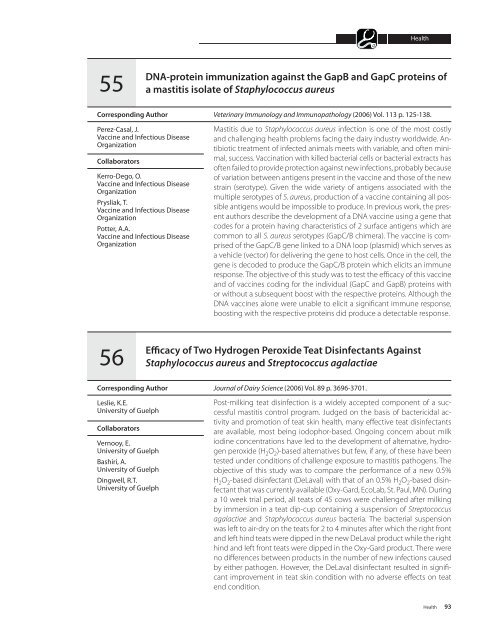A52-75-2007E.pdf - AgroMedia International Inc
A52-75-2007E.pdf - AgroMedia International Inc
A52-75-2007E.pdf - AgroMedia International Inc
You also want an ePaper? Increase the reach of your titles
YUMPU automatically turns print PDFs into web optimized ePapers that Google loves.
Health55DNA-protein immunization against the GapB and GapC proteins ofa mastitis isolate of Staphylococcus aureusCorresponding AuthorPerez-Casal, J.Vaccine and Infectious DiseaseOrganizationCollaboratorsKerro-Dego, O.Vaccine and Infectious DiseaseOrganizationPrysliak, T.Vaccine and Infectious DiseaseOrganizationPotter, A.A.Vaccine and Infectious DiseaseOrganizationVeterinary Immunology and Immunopathology (2006) Vol. 113 p. 125-138.Mastitis due to Staphylococcus aureus infection is one of the most costlyand challenging health problems facing the dairy industry worldwide. Antibiotictreatment of infected animals meets with variable, and often minimal,success. Vaccination with killed bacterial cells or bacterial extracts hasoften failed to provide protection against new infections, probably becauseof variation between antigens present in the vaccine and those of the newstrain (serotype). Given the wide variety of antigens associated with themultiple serotypes of S. aureus, production of a vaccine containing all possibleantigens would be impossible to produce. In previous work, the presentauthors describe the development of a DNA vaccine using a gene thatcodes for a protein having characteristics of 2 surface antigens which arecommon to all S. aureus serotypes (GapC/B chimera). The vaccine is comprisedof the GapC/B gene linked to a DNA loop (plasmid) which serves asa vehicle (vector) for delivering the gene to host cells. Once in the cell, thegene is decoded to produce the GapC/B protein which elicits an immuneresponse. The objective of this study was to test the efficacy of this vaccineand of vaccines coding for the individual (GapC and GapB) proteins withor without a subsequent boost with the respective proteins. Although theDNA vaccines alone were unable to elicit a significant immune response,boosting with the respective proteins did produce a detectable response.56Efficacy of Two Hydrogen Peroxide Teat Disinfectants AgainstStaphylococcus aureus and Streptococcus agalactiaeCorresponding AuthorLeslie, K.E.University of GuelphCollaboratorsVernooy, E.University of GuelphBashiri, A.University of GuelphDingwell, R.T.University of GuelphJournal of Dairy Science (2006) Vol. 89 p. 3696-3701.Post-milking teat disinfection is a widely accepted component of a successfulmastitis control program. Judged on the basis of bactericidal activityand promotion of teat skin health, many effective teat disinfectantsare available, most being iodophor-based. Ongoing concern about milkiodine concentrations have led to the development of alternative, hydrogenperoxide (H 2 O 2 )-based alternatives but few, if any, of these have beentested under conditions of challenge exposure to mastitis pathogens. Theobjective of this study was to compare the performance of a new 0.5%H 2 O 2 -based disinfectant (DeLaval) with that of an 0.5% H 2 O 2 -based disinfectantthat was currently available (Oxy-Gard, EcoLab, St. Paul, MN). Duringa 10 week trial period, all teats of 45 cows were challenged after milkingby immersion in a teat dip-cup containing a suspension of Streptococcusagalactiae and Staphylococcus aureus bacteria. The bacterial suspensionwas left to air-dry on the teats for 2 to 4 minutes after which the right frontand left hind teats were dipped in the new DeLaval product while the righthind and left front teats were dipped in the Oxy-Gard product. There wereno differences between products in the number of new infections causedby either pathogen. However, the DeLaval disinfectant resulted in significantimprovement in teat skin condition with no adverse effects on teatend condition.Health 93





